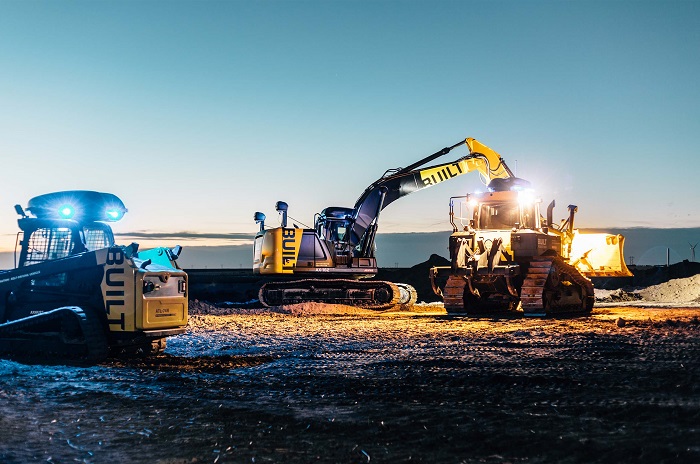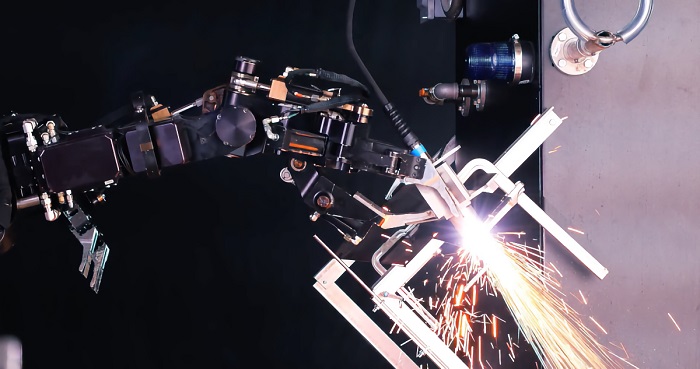ISABEL RUBIO ARROYO | Tungsteno
Autonomous robots that lay 1,000 bricks an hour and erect homes in two days. Exoskeletons that boost the strength of the wearer by a factor of 20. Sensors that monitor the heart rate or posture of workers. Systems that take the winter cold into account when planning a project. Artificial intelligence promises to completely revolutionise the construction industry. More and more companies are using this type of technology to improve project management and implementation, save costs and ensure worker safety.
The construction of a building involves all types of machines and workers, from draughtsmen, architects and engineers to bricklayers, electricians, truck drivers and crane operators. Getting them all to work efficiently while minimising any risks is a key challenge. Artificial intelligence can help achieve this, as well as delivering significant savings in time and resources. A report by the consultancy EY shows that this technology can reduce the time spent on meetings related to the job site by up to 70% and save more than 60,000 euros per year per project.
Evaluating millions of possible scenarios to predict the evolution of a project
"Around 200 years ago, the industrial revolution changed society in unimaginable ways for the time. Today, another revolution is under way," says Marc Lahmann, project management expert at PwC. He is referring to the artificial intelligence revolution and how this technology will transform project management across the board, for example by automating tasks or avoiding costly delays in construction processes.
ALICE is a platform that uses artificial intelligence to improve project management in construction and mitigate risks. In theory, it can reduce the duration of each project by 17% and save 14% in labour costs. The software does in just a few minutes what would take a human being years to complete. It calculates millions of hypothetical scenarios taking into account all the variables that influence the construction of a building and selects the most efficient solutions.
This platform has been used to plan the construction of a luxury building with an outdoor pool, gym and garden in Bangkok and the extension of the City of Edmonton light rail in Alberta, Canada. In the latter project, ALICE took into account factors such as the difficulties in constructing in winter weather. In addition, the AI-powered platform also created schedules to optimise the work of construction crews and to minimise the number of concrete pumps needed.

Artificial intelligence can improve project management in construction and mitigate risks. Credit: Pexels.
Robots and autonomous excavators to speed up the construction process
Beyond project management, artificial intelligence can be particularly useful in on-site construction. While we wait for autonomous vehicles to become a reality on the streets, autonomous driving technology could appear first in the construction industry. Companies such as Caterpillar, Komatsu, SafeAI and Built Robotics are working to make this possible. This last company is developing machines that operate fully autonomously, for example excavators that can dig trenches or level land 24 hours a day. These machines have been used for example by Mortenson, a large US construction company, to build solar and wind farms.
Sarcos Robotics is another company that has been designing robots to increase human productivity and safety in hazardous jobs for 25 years. Among its creations is Guardian XO, an exoskeleton designed to manipulate heavy loads using the body's natural movements. The company claims that this robotic suit can boost the wearer's strength by a factor of 20. In theory, an operator could safely lift and manoeuvre up to 90 kilos for eight hours at a time with little effort.
Some robots can be used to erect structures in record time. Guardian GT is a gigantic, remote-controlled double-armed robot capable of lifting more than 450 kilos and also carrying out more complex welding and assembly processes. Also of note is Hadrian X, a robot developed by Australian company Fastbrick Robotics that is able to lay 1,000 bricks in just one hour and construct the walls of a home in less than two days. "In the right environment and working continuously, each unit could build between 100 and 300 homes per year," says the company, which claims the process generates less waste than traditional construction methods.

Some autonomous excavators can trench or level terrain 24 hours a day. Credit: Built Robotics.
Machine learning and sensors to improve safety
An article by the consulting firm McKinsey & Company indicates that machine learning can be applied to drone imagery and 3D-generated models to assess defects in the execution of a project, "both structural and aesthetic." It can also be used for the "early detection of critical events (e.g., bridge failure)." "These techniques could help engineers compare developing and final products against initial designs, or train an unsafe-behaviours detection algorithm to identify safety risks in project sites based on millions of drone-collected images," the firm says.
Increasingly, construction sites are equipped with cameras, IoT devices and sensors that constantly monitor the scene. Facial and object recognition technology can detect unsafe behaviour and warn of potential hazards. Sensors, together with artificial intelligence systems, serve to monitor conditions relevant to construction and materials such as temperature or humidity in the environment. These devices can also be present in wearables worn by workers themselves to monitor heart rate, body temperature, repetitive movements or posture. For example, Wearlumb, a smart T-shirt designed for the workplace, measures the posture of workers and suggests ways for improvement to minimise the risks and costs of lower back disorders.
Artificial intelligence can play an important role in the prevention of occupational hazards. In the United States, more than 5,000 workers died on the job in 2019, according to the country's Occupational Safety and Health Administration. That's more than 100 employees per week, or about 15 every day, and one in five deaths occurred in the construction field. Suffolk, a Boston-based general contractor, is developing an algorithm that analyses photos from its construction sites and scans them for safety hazards, such as workers not wearing protective equipment. The images are then correlated with its accident records so that safety briefings can be conducted when a potential threat is detected.
All these technologies can be useful during the construction process, but once the project is completed they still have great potential. For example, sensors attached to doors, windows, tables or chairs can constantly monitor everything from temperature and air quality to humidity, atmospheric pressure and even which lights are on or which doors or windows are open. The processing of millions of pieces of data with artificial intelligence systems serves to ensure the efficient use of resources and to keep buildings in the best possible condition.
· — —
Tungsteno is a journalism laboratory to scan the essence of innovation. Devised by Materia Publicaciones Científicas for Sacyr’s blog.
